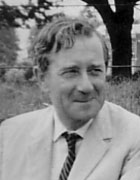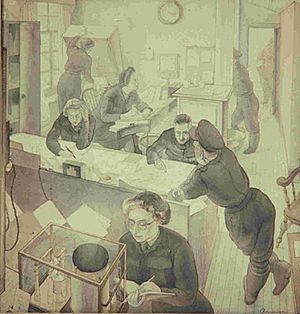George Worsley Adamson facts for kids
Quick facts for kids
George Worsley Adamson
|
|
|---|---|

Adamson at Pynes House, Upton Pyne, 1966
|
|
| Born | 7 February 1913 The Bronx, New York, U.S.
|
| Died | 5 March 2005 (aged 92) Exeter, Devon, England
|
| Occupation | Illustrator and cartoonist |
| Spouse(s) | Mary Marguerita Renée Diamond (1917–1997) |
George Worsley Adamson (born February 7, 1913 – died March 5, 2005) was a talented artist. He was known for illustrating books, writing, and drawing cartoons. George was a citizen of both America and the United Kingdom from 1931.
Contents
Early life and education
George Adamson was born in the Bronx, New York City. His father, George William Adamson, was a skilled builder of train cars. His mother was Mary Lydia Howard. His parents had moved to New York from Bombay, India, in 1910.
When George was eight, his mother passed away in February 1921. He then sailed to England with his father and two sisters. They arrived in Liverpool in July. His father returned to New York and died the next year.
George went to the Wigan Mining and Technical College. He also studied art at the Liverpool City School of Art. There, he learned how to create etchings and engravings.
His artwork was shown at the Royal Academy several times. He also drew for the famous Punch magazine for many years, from 1939 to 1988.
World War II service
During World War II, George Adamson served in the RAF Coastal Command. He was a navigator on flying boats, which are planes that can land on water. He flew missions over the Atlantic Ocean.
After he drew pictures for an article about flights across the Atlantic, he became an official war artist. This meant he was hired to create art about the war. Some of his drawings from this time are now in the Imperial War Museum and the RAF Museum.
Career as an artist
After the war, from 1946 to 1953, George taught art. He taught engraving and illustration at the Exeter School of Art in England.
In 1954, he decided to become a full-time illustrator and cartoonist.
Illustrator of books
George Adamson illustrated many books. His first book was Marjorie Vasey's The Day is Over in 1954.
He became very well-known for illustrating the Professor Branestawm books by Norman Hunter. His drawings perfectly matched the silly and quirky stories.
He also created the covers for Alan Garner's first two children's novels: The Weirdstone of Brisingamen (1960) and The Moon of Gomrath (1963).
George also worked with the famous poet Ted Hughes. He drew pictures for Hughes's children's poetry book, Meet My Folks! (1961). He also illustrated Hughes's story collections, How the Whale Became (1963) and the first edition of The Iron Man (1968).
In the 1970s, he illustrated books based on the popular TV series Catweazle. Later, in the 1980s, he drew for the "Dear Bill" books, which were funny letters from a magazine called Private Eye.
Besides books, George Adamson also illustrated articles for magazines like The Listener and Nursing Times. He drew over 200 pictures for Nursing Times between 1963 and 1983.
Cartoonist
George Adamson's first cartoon appeared in Punch in 1939. His last cartoon was in The Spectator in 1994. Over 55 years, his cartoons were published in many magazines. These included Punch, Tatler, Time & Tide, The Daily Telegraph, and Private Eye.
A writer named Miles Kington once described a clever cartoon George drew for Punch. It showed Mr. Punch trying to paint a landscape. But the landscape itself was a mix of different famous painters' styles! Kington thought it was a brilliant idea.
Engraver and etcher
From his art school days, George loved dry-point etching and aquatint. These are special ways of making prints. After World War II, he made many etchings for fun while teaching art.
He took a break from printmaking for many years to focus on illustrating and cartooning. But in the late 1970s, he returned to it with excitement. He showed his old and new prints at the Royal Society of Painter-Etchers and Engravers.
Artwork in public collections
George Adamson's art can be found in several public museums and galleries. Here are some of them:
- Ashmolean Museum, Oxford
- British Museum, London
- Imperial War Museum, London
- New York Public Library, New York
- Royal Air Force Museum, Hendon
- Victoria and Albert Museum, London
Selected works
George Adamson wrote and illustrated some books himself:
- A Finding Alphabet (1965)
- Finding 1 to 10 (1967)
- Rome Done Lightly (1972)
He illustrated many other books, including:
- Alan Garner's The Weirdstone of Brisingamen (1960) and The Moon of Gomrath (1963)
- Ted Hughes's Meet My Folks! (1961), How the Whale Became (1963), and The Iron Man (1968)
- Norman Hunter's Professor Branestawm books (from 1966)
- Richard Carpenter's Catweazle (1970)
He also designed covers for music records and CDs.
Selected exhibitions
George Adamson's work was shown in many exhibitions throughout his life. Here are a few notable ones:
- Royal Academy, London (1937, 1939, 1940, 1948)
- Arts Council: "Book Illustration" (1958)
- Wilhelm Busch Museum, Hanover, Germany: Punch drawings (1963)
- Royal Albert Memorial Museum, Exeter: "Adamson Exhibition" (1968)
- Cartoon Museum, London: "Private Eye at 45" (2006)
- Victoria and Albert Museum, London: "George W. Adamson: A Twentieth-Century Illustrator" (2012)
- British Library, London: "Picture This: Children's Illustrated Classics" (2013)
Awards and honours
In 1981, George Adamson won the P.G. Wodehouse Centenary Illustration Award from Punch. Because of this, he was asked to illustrate a collection of P.G. Wodehouse short stories.
In 1987, George Adamson was made a fellow of the Royal Society of Painter-Printmakers. This is a special honor for artists who create prints.


